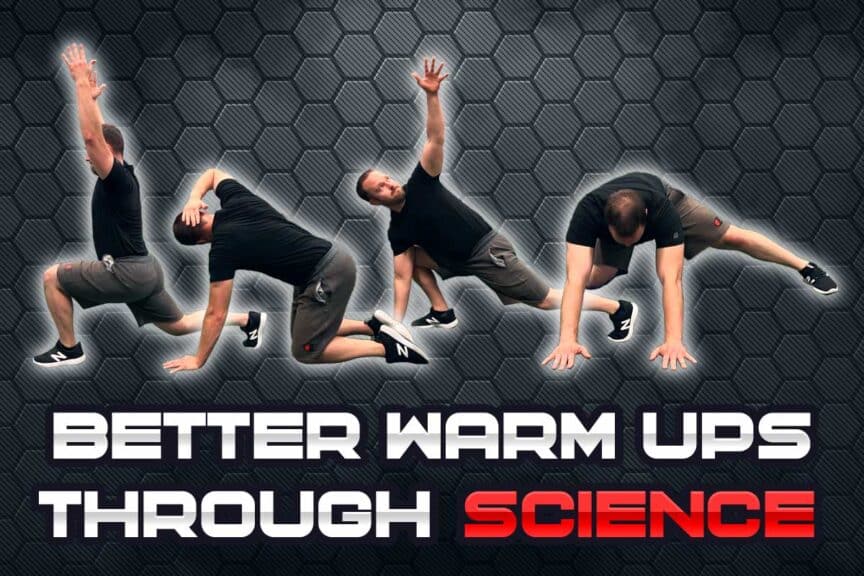Enhanced muscle performance. Better nervous system potentiation. Decreased injury potential. Those are some of the primary benefits you’ll experience when you get when you know how to perform an effective dynamic warmup series. It’s proven by science.
So, in this article, I’ll be going over what you need to know about optimizing dynamic warmups so that you can reap some significant benefits. It’s so profound that I will mention it one more time:
Benefits of a dynamic warmup before physical activity include vastly improved performance, decreased risk of injury, improved mobility, decreased pain and even improved cardiovascular health. These benefits extend to everyday life and are not confined merely to individual exercise sessions.
Keep on reading if you want the scientific details behind how and why this all happens and what it ultimately means for you as someone looking to take better care of your body!
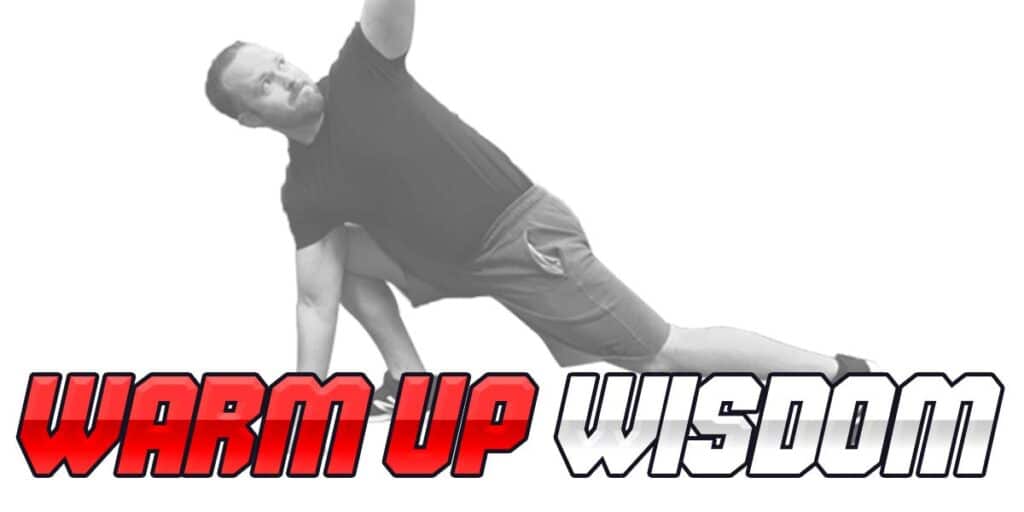
Free dynamic warmup series
Real quick, before you read the rest of this article:
I’ve got a free PDF document and a series of completely FREE dynamic warmups that you can try, modify and use based on your needs if you want to try some dynamic warmups that have worked very well for my athletes over the years.
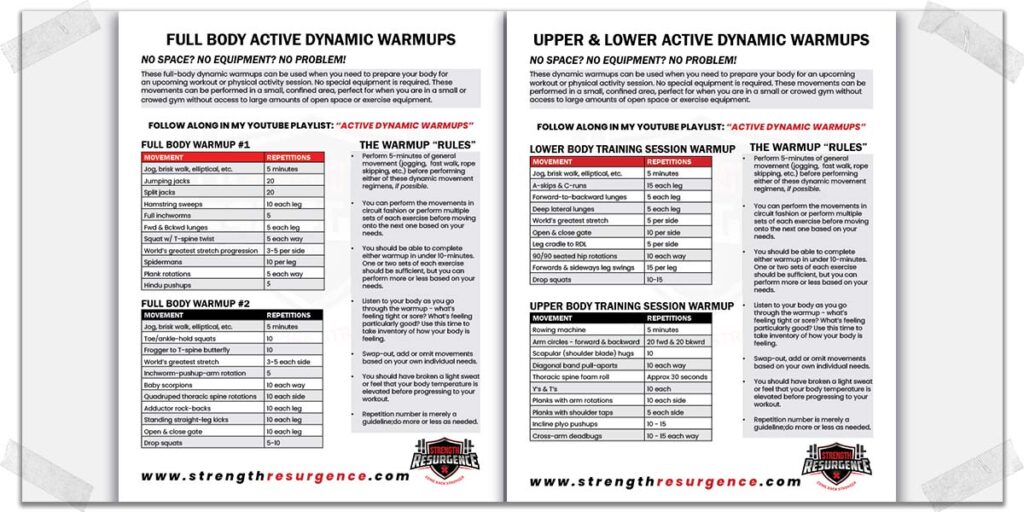
In this other blog post, I’ve filmed videos of each series of exercises with a narrated walkthrough for each individual movement. You’ll also find a write-up for knowing when and how to incorporate each one. So, pick which sounds the best for you and have at it.
Each warmup series is generalized to the extent that it should work for various physical activity sessions, such as working out in the gym or warming up for a sporting event. But the key with any of them is to modify and customize the movements you perform so that it’s ideal for your needs and abilities. So use them as a starting point and refine them to your own desires!
Ok, on with the article!
Dynamic warmups: a VERY good idea
If you’re not quite sure what exactly a dynamic warmup (sometimes called an active dynamic warmup) is, ultimately, a dynamic warmup is a way to physically prepare your musculoskeletal system (your muscles, tendons, and joints) and nervous system for the upcoming physical activity demands you’ll be exposing them to. It usually consists of a series of movements rather than one single movement.
When your body’s tissues (muscles, tendons, nerves, etc.) are adequately prepared, you will see a noticeable improvement in your body’s performance abilities, improving your athleticism and reducing injury potential. They have quite reasonable scientific evidence for their effectiveness, so it’s likely a good idea to know the basics of incorporating them into your physical activities.
Some of the routinely reported scientific findings of the positive effects of dynamic warmups include:
- Enhanced range of motion around joints
- Increases in muscle force and power (jump height, sprint speed, etc.)
- Increased muscle temperature (decreasing injury potential)
- Improved agility
These positive effects are largely attributable to changes in muscle dynamics and increases in the speed of nerve transmissions within the body. I’ll get into these specifics in the following sections, so let’s get to it!
Dynamic movements vs static stretching

So, what makes a dynamic warmup different from traditional static stretching exercises? Well, for starters, we’re using—as the name implies—dynamic movements to prepare the body rather than stretches that require the body to be held still.
When it comes to static stretching, this traditional form of stretching isn’t nearly as beneficial as we once thought it to be, so we want to use something much more effective when preparing for a physical activity such as a workout or a sporting event.
Physiologists and other experts used to think that static stretching would help muscles warm up and prevent injury (which is why we did them before physical activity). Unfortunately, there’s one particular problem with this type of stretching, among others, that I’ll quickly mention.
Statically stretching a muscle before physical activity can actually reduce the muscle’s performance potential.1–3
This is essentially because holding a muscle in a lengthened position will neurologically inhibit the muscle. Think of it as making the muscle a bit sleepy – which is the LAST thing you want to do when trying to prepare them for physical activity; you want your muscles to be awake and ready to go.
Now, to be clear, it doesn’t mean static stretching is evil, but rather that it’s just likely not the ideal intervention to use before a workout. Instead, doing it after a workout or on a non-resistance training day would be a more ideal time to do so.
It is believed that there are two mechanisms by which dynamic stretching reduces the chances of incurring muscle and tendon tissue strains.
…The combination of the elastic properties of connective tissue combined with the viscous properties of the fluid within it creates what’s known as the viscoelastic property of connective tissue.
Additionally, stretching doesn’t help with increasing blood flow into the muscles or getting your nervous system, which speaks to those muscles, ready for physical activities. And we need to do this because a warm muscle filled with blood will likely be more supple and move better than one that isn’t, which can significantly reduce injury potential.3 Also, a muscle with elevated neurological input will perform better for physical activity.
So, we’re going to need something better than static stretching. And this is where dynamic warmups can really shine.
What an effective dynamic warmup looks like
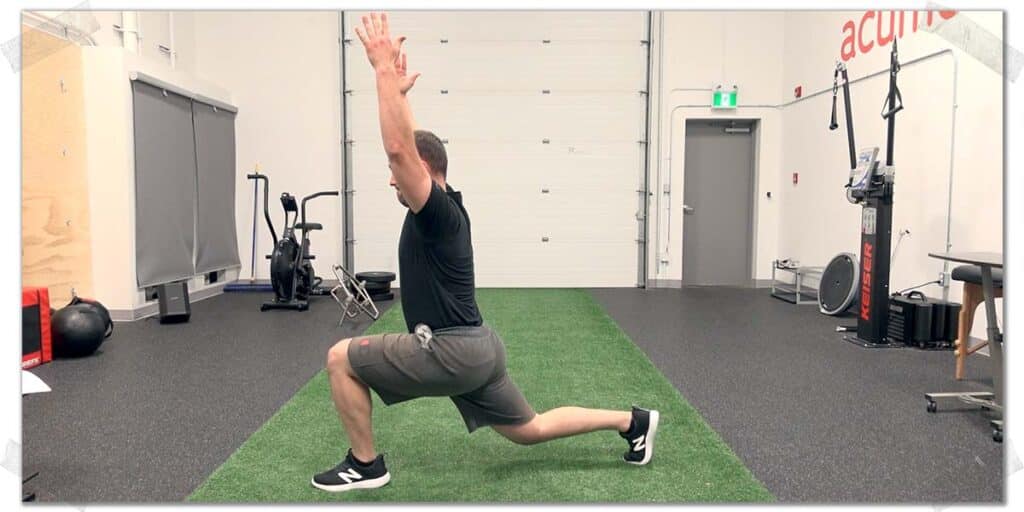
So, what makes for an effective and ideal dynamic warmup? Well, a good dynamic warmup is one that will achieve a few objectives:
- Raise your body’s core temperature enough to have you break a light sweat by performing a series of full-body generalized movements.
- Prepare your muscles and joints by performing a few movements that are similar to some of the movements you’ll be putting your body through during your workout or physical activity session.
- Prepare your nervous system to improve its efficiency in activating your muscles (known as potentiation…more on that later).
The result is an elevated blood flow rate throughout your limbs and increased sympathetic activity from your nervous system. In other words: it lets your body know it’s “go” time!
Analogy: Think of an elevated rate of blood flow into your muscles like priming the fuel lines in an engine and ramping up the sympathetic activity in your nervous system like increasing the idling RPMs; it all just means that your body is much more ready to go than if you simply hopped right into your activity session.
One critically important concept to understand with dynamic warmups is that there’s no single, universal best movement or series of movements to perform. There are some general concepts to be mindful of, but so long as you’re following said concepts, you can pick and use movements that feel best for your needs or abilities.
One critically important concept to understand with dynamic warmups is that there’s no single, universal best movement or series of movements to perform. There are some general concepts to be mindful of, but there’s plenty of room for customization.Click to PostImproved physical performance
So far, I’ve briefly mentioned that a good dynamic warmup will likely lead to better performance with your activities—but I haven’t mentioned the details as to how. So, to enlighten you and help you truly appreciate just how multifaceted and profound these benefits are, I’ll break them into a few different sub-sections.
Enhanced central nervous system potentiation
Potentiation refers to an increase in the strength of nerve pulses along pathways of nerves that have been used from a previous activity. It’s essentially the result of improved synaptic activity (one nerve better communicating with another). To be clear, the extent of potentiation that takes place from your dynamic warmup will depend on the movements, intensity, and speed of movements you perform.
A good dynamic warmup doesn’t necessarily aim to have every movement working towards solely increasing your nervous system’s potentiation; rather, it will have a couple of movements (typically performed at the end of the series) that are specifically utilized for this purpose. (This is what the drop squats and bench plyo pushups are used for in my dynamic warmup series).
Additionally, utilizing a dynamic warmup will help your body switch from a particular division of your nervous system, known as the parasympathetic division (the “rest and digest” nervous system), to utilizing more of your sympathetic nervous system (the “fight or flight” nervous system).4
The bottom line: No matter how fit your cardiovascular system is, how big your muscles are or how mobile your body may be, your physical performance is ultimately dictated by your central nervous system (CNS); it’s the electrical system that supplies the power to your heart and muscles (among other parts of your body).
Drastically reduced pain & injury potential
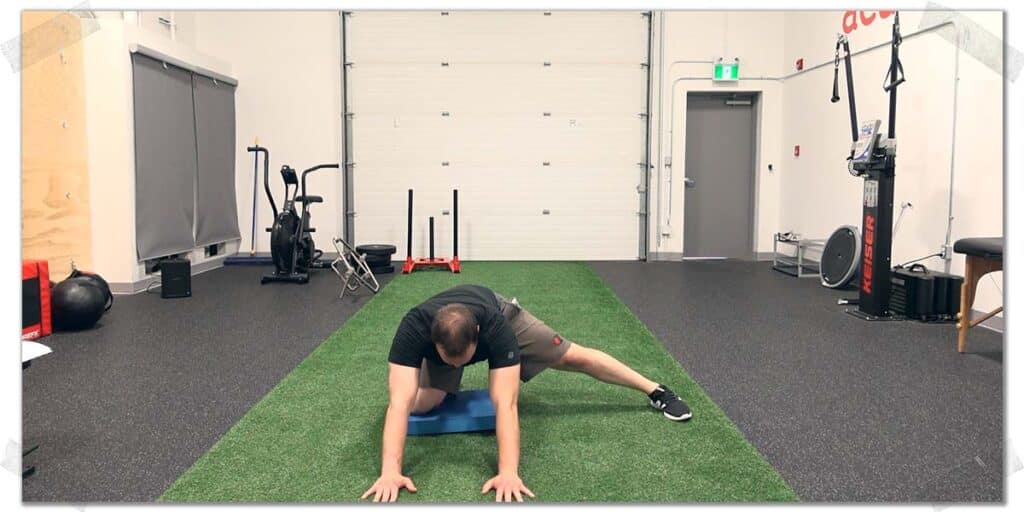
It’s no secret that the better the body moves and the more prepared it is for movement, the less pain and discomfort we generally experience while moving. Most people are aware of this; a body that moves better during an activity tends to be less problematic and plagued with pain.
It ultimately comes down to improving muscle dynamics; by increasing the temperature of working muscles, vasodilation occurs, increasing blood flow within the muscle tissue, which allows for a more significant influx of oxygen to the working tissues.5
Altering viscoelasticity: Reducing the risk of muscle strains
A muscle strain (often called a “pulled muscle”) refers to a sudden force that overstretches a muscle, which can lead to discomfort and pain (of varying degrees). It is believed that there are two mechanisms by which dynamic stretching reduces the chances of incurring muscle and tendon tissue strains:3
- By increasing the overall elasticity of the muscle and tendon tissue, essentially making it more pliable and tolerant to lengthening and deforming when being stretched or acted upon by an outside force.
- Through decreasing the viscosity (thickness) of fluid within and around the muscles (which occurs due to increased muscle temperature).
The combination of the elastic properties of connective tissue combined with the viscous properties of the fluid within it creates what’s known as the viscoelastic property of connective tissue. When a greater extent of muscle and tendon lengthening can occur (the elastic component), and the fluid within those tissues is less thick (lower viscosity), their capacity to lengthen out without incurring damage increases.6
Decreasing delayed onset muscle soreness
Delayed onset muscle soreness (DOMS) is the phenomenon that occurs when your muscles become stiff and sore one or two days following your workout or activity session.
While I haven’t found any particular articles that have examined the effects of dynamic warmups reducing the amount of delayed muscle soreness experienced, it stands to reason that a dynamic warmup could likely reduce the extent of DOMS following an intense workout or physical activity session.
The theory (at least by me) would be that muscles that already have an elevated temperature, increased blood flow, and lower fluid viscosity by the time the first intense exercise is performed will be better able to cope with the demands they receive.
As such, the muscles aren’t “caught off guard” and, therefore, can better meet the demands they’re exposed to. The end result is muscles that aren’t taxed and strained quite as much throughout each exercise or movement, which could lead to a reduction in DOMS (and, thus, faster recovery).
Improved flexibility and mobility (during and after)
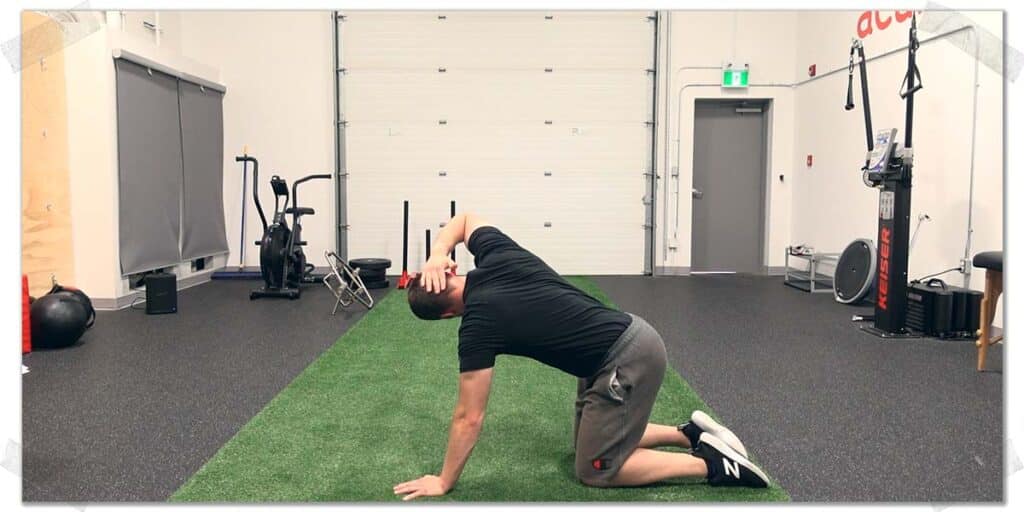
The changes in the viscoelasticity of muscle and tendon tissues from a dynamic warmup won’t only help to reduce injury potential; they’ll also help to improve your overall mobility. Better mobility means improved ranges of motion through which you can move your muscles and joints, which can lead to significantly improved athleticism (a strong body doesn’t mean much if it can’t move well).
Tissue flexibility has two components that contribute to its ability to lengthen:
- Its elastic component (elasticity)
- Its plastic component (plasticity)
Elasticity refers to the tissue’s ability to recoil after it has been stretched. This flexibility component is altered mainly by changing its viscoelasticity (discussed in the previous section).
Plasticity refers to the tissue’s ability to stretch without recoiling afterwards.
The great thing about performing dynamic warmups on a regular basis is that you’ll likely experience improved tissue plasticity, meaning you’ll have some permanent improvement to your mobility and not just transient improvement only during your activity).
Tissue plasticity and muscle creep
The remarkable thing about tissues within the human body (muscle tissue, tendon tissue, capsular tissue, etc.) is that it has the propensity to adapt to chronic (repeated and ongoing) demands placed upon them. In the case of dynamic movements, these tissues can potentially alter their plasticity through a mechanism known as “creep.”
Creep refers to a tissue’s tendency to deform to the continual demands that it experiences. This can be a favorable or unfavourable characteristic of these tissues, based on whether you move too little (unfavourable) or move a lot (favorable).
In other words: If you constantly keep your muscles and joints in shortened positions (such as sitting at a desk all day long), your tissues can become chronically shortened and have difficulty lengthening out. Conversely, if you constantly perform large ranges of movement that challenge these tissues in their mobility and extensibility, they will adapt to be able to meet those demands.
Now, to be clear, changes in tissue plasticity may be better served through more traditional static stretching exercises/routines (which should be done after a workout or on non-workout days). But it stands to reason that dynamic movements that are slower in nature, performed through large ranges of motion) and performed regularly could at least prevent (if not mildly improve) adverse effects of tissue creep.
This would ultimately mean that dynamic movements would prevent tissue creep from occurring in the wrong direction, essentially offsetting the effects of your mobility becoming worse.
The “best” dynamic warmup to perform
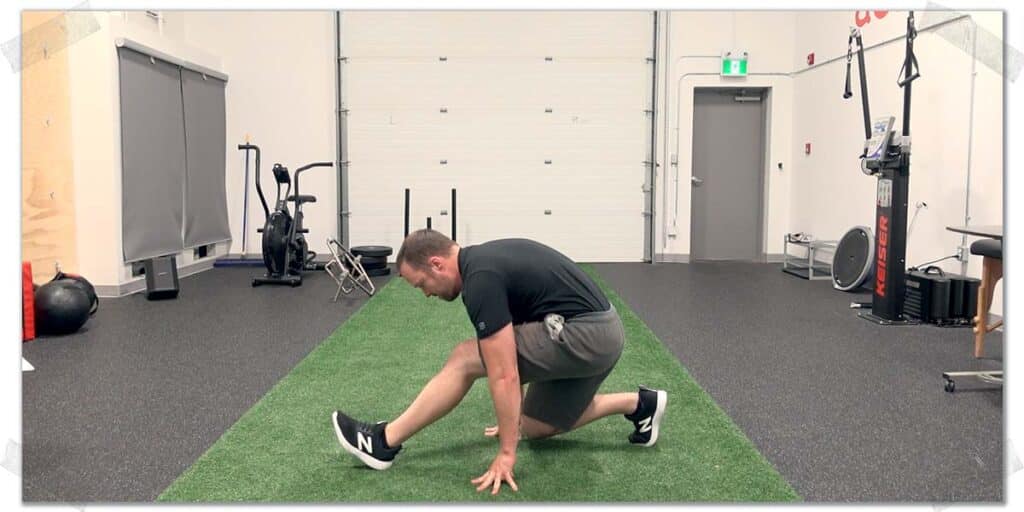
One critically important concept to understand with dynamic warmups is that there’s no single, universal best movement or series of movements to perform. There are some general concepts to be mindful of, but so long as you’re following said concepts, you can pick and use movements that feel best for your needs or abilities.
Some of the general concepts you’ll want to follow include the following:
- Performing movements that provide a rather mild and brief stretch rather than movements that aggressively stretch a muscle or joint or a stretch that’s held for a long duration of time.
- Starting your series of movements with slower-paced, more generalized movements, and then progress to more specific, demanding, or faster movements.
- Modifying or avoiding any movements that are painful, uncomfortable or otherwise problematic for you.
- Making sure you’ve broken a light sweat or at least feel like you’re warmed up by the end of your series of movements.
Generally speaking, a solid dynamic warmup shouldn’t take any longer than about ten minutes. However, it can depend on the upcoming activity you’ll be performing (and a few other unique factors).
More calories burned & better overall conditioning
As stated a moment ago, an effective dynamic warmup is one that will have you breaking a light-to-mild sweat by the time you’re ready to dive into your main physical activity. A light, full-body sweat means that your body is adequately prepared, and a series of warmup exercises can be a mini-workout in itself.
If you’re someone who is working out with a primary goal of weight loss or improved overall physical conditioning, a solid dynamic warmup will serve as an additional means by which you can help your body burn more calories and gain more endurance.
Remember: An adequate dynamic warmup series will keep your heart rate mildly elevated for around ten continual minutes before you dive into your actual workout or activity session. So, you can be assured that it will improve or, at least, maintain your conditioning that much more (depending on how fit or unfit you are, of course).
Bonus: Inventory of your movement
One seriously underrated benefit to incorporating dynamic warmups into your regimen is learning just how well (or poorly) your body is moving overall—either for a given area or throughout your entire body.
Many individuals make the mistake of thinking that their overall mobility and tissue health are just fine (or at least adequate enough). But the fact of the matter is that tissue and movement dysfunction often go undetected in our body until we attempt to perform large ranges of motion or demanding movements.
At this point, we often get a rude awakening to our overall state of mobility. Dynamic warmups and movements can help you raise awareness towards issues such as the hamstrings being way tighter on one leg than the other or that your shoulder doesn’t like a particular movement that shouldn’t be an issue.
But thankfully, by going through dynamic warmups, we expose ourselves to positions and movements that can raise awareness of issues we’d otherwise be unaware of.
And once we’re aware of these issues, we can begin to take action to correct them. And when it comes to this awareness and subsequent correction process, always remember the second rule of health and wellness to follow:
Never let a minor issue become a major issue.
Attack the mobility or discomfort issue while it’s minor and relatively new. The longer you let it go on, the worse it can become, and the harder—and longer—the process will be to resolve it entirely.
Final thoughts
Alright, with that being said, go warm yourself up and get movin’!
Also: A big shout-out to Acumen Performance here in Calgary for allowing me to use their facility for filming my dynamic warm-up videos!
References:

Hi! I’m Jim Wittstrom, PT, DPT, CSCS, Pn1.
I am a physical therapist who is passionate about all things pertaining to strength & conditioning, human movement, injury prevention and rehabilitation. I created StrengthResurgence.com in order to help others become stronger and healthier. I also love helping aspiring students and therapists fulfill their dreams of becoming successful in school and within their clinical PT practice. Thanks for checking out my site!

